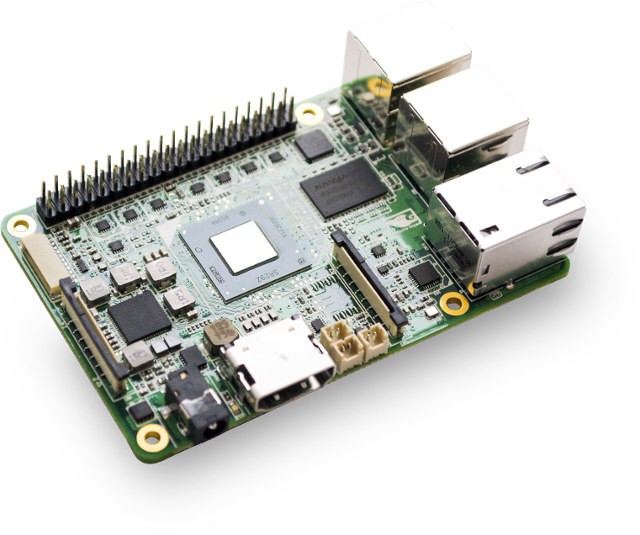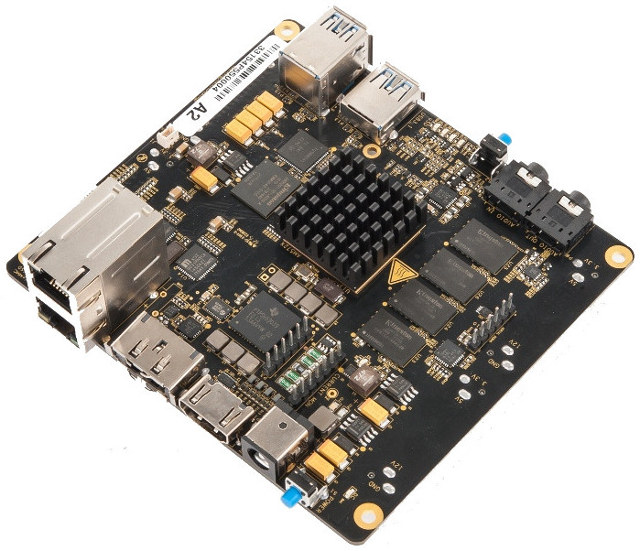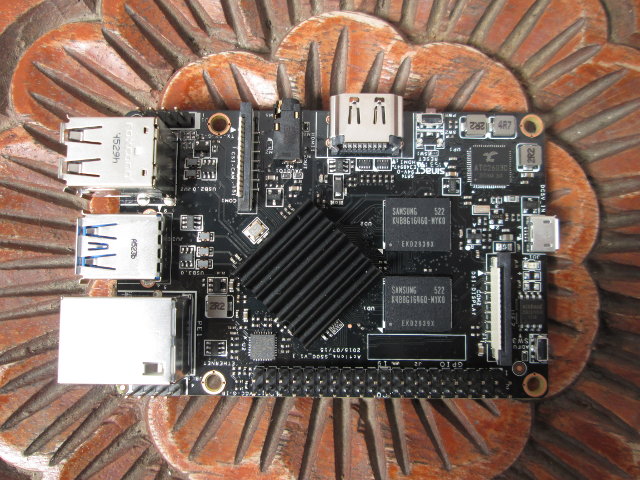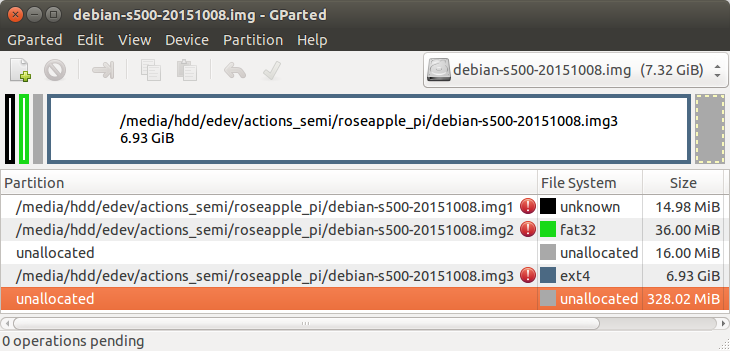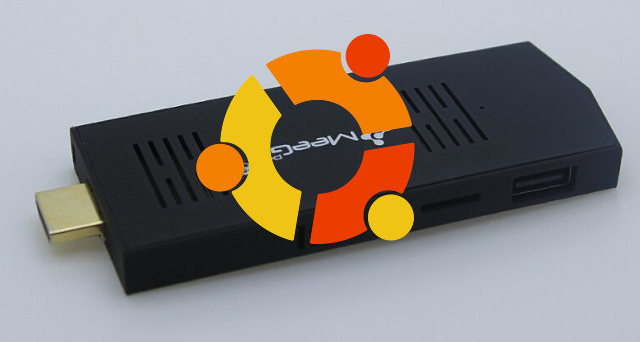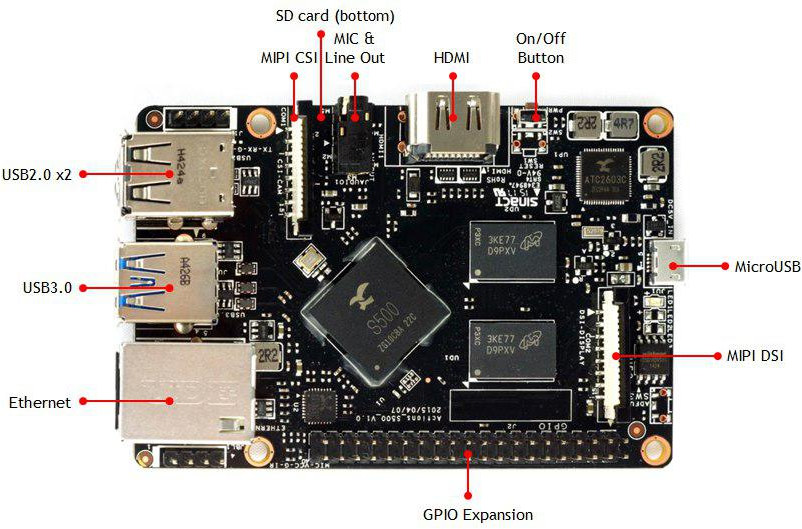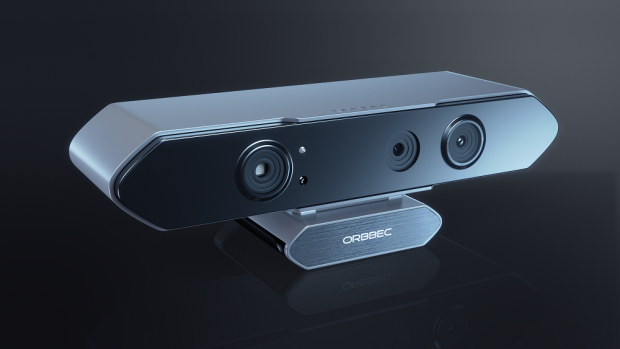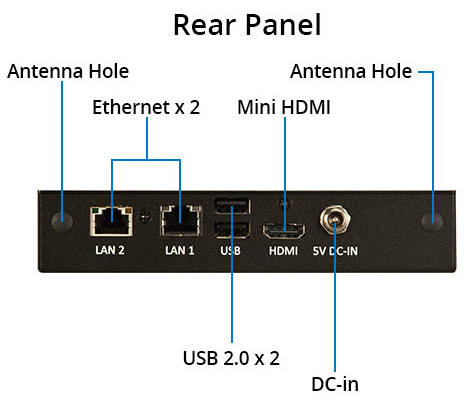Many ARM based “insert-fruit-name-here” Pi boards are available on the market, and they all look like the Raspberry Pi board to some extends, but thanks Emutex we’ll soon get the “UP board” powered by Intel Atom x5-Z8300 and in Raspberry Pi form factor including the ubiquitous 40-pin Raspberry Pi headers, DSI and CSI connectors, and mostly the same port placements, with some extra goodies like a USB 3.0 port and Gigabit Ethernet. Up Board specifications: SoC – Intel Atom x5-Z8300 “Cherry Trail” quad core processor @ 1.44 GHz (Burst frequency: 1.84 GHz) with Intel Gen8 HD graphics @ 500 MHz System Memory – 1 GB DDR3L-1600 Storage – 16 or 32 GB eMMC Video Output / Display – HDMI, DSI connector Audio I/O – HDMI Connectivity – Gigabit Ethernet USB – 4x USB 2.0 host ports, 1x USB 2.0 pin header, 1x micro USB 3.0 port (under the board) Camera […]
BeagleBoard-X15 Board Based on TI Sitara AM5728 SoC Announced, To Sell for $239
We’ve first found out about Beagleboard-X15 open source hardware board about a year ago, and development has taken a bit longer than expected, but Beagleboard.org has now formally launched BeagleBoard-X15, which remains based on Texas Instruments Sitara AM5728 dual Cortex A15 processor, and is expected to ship before Christmas for $239. The key part of the specifications are still the same as last year, but we’ve got a few more details now: SoC – Texas Instruments Sitara AM5728 with: Two ARM Cortex A15 cores @ 1.5 GHz PowerVR SGX544-MP2 3D GPU, Vivante GC320 2D GPU Two Cortex M4 cores @ 212 MHz Dual core C66x DSP @ 700 MHz IVA (Image and Video Accelerator) for 1080p video decode (H.264, VC-1, MPEG 1/2/4, AVS, etc..) Four 32-bit PRUs (Programmable Real-time Units) System Memory – 2GB DDR3L @ 533MHz Storage – 4GB 8-bit eMMC flash, micro SD slot, and eSATA interface (500 […]
Linux Quick Start Guide for Roseapple Pi Board based on Actions Semi S500 Processor
Roseapple Pi is a development board powered by Actions Semi S500 processor with 2GB RAM, a USB 3.0 port and more, that is based on Actions Semi Bubblegum-S500 reference design also used by Lemon Pi board. The team behind the project sent me an early sample to try it out. I’ll take some pictures, before explaining how to install and setup Debian 8.1, and how to build and run your own minimal image from source. These instructions should also work for Lemon Pi and LeMaker Guitar boards. Roseapple Pi Photos I received the board in a bubble envelope with a thank you letter, and the board itself in an anti-static bag. No other accessories were provided. Ports, connectors, and headers from top left counter-clockwise: 4-pin UART console, two USB 2.0 ports, one USB 3.0 port, 10/100 Ethernet, a 40-pin Raspberry Pi comptabile header, a MIPI DSI connected, a micro USB […]
How to Reduce SD Card Firmware Images Download Size
So I’ve just received a Roseapple Pi board, and I finally managed to download Debian and Android images from Roseapple pi download page. It took me nearly 24 hours to be successful, as the Debian 8.1 image is nearly 2GB large and neither download links from Google Drive nor Baidu were reliable, so I had to try a few times, and after several failed attempt it work (morning is usually better). One way is to use better servers like Mega, at least in my experience, but another way to reduce download time and possibly bandwidth costs is to provide a smaller image, in this case not a minimal image, but an image with the same exact files and functionalities, but optimized for compression. I followed three main steps to reduce the firmware size from 2GB to 1.5GB in a computer running Ubuntu 14.04, but other Linux operating systems should also […]
MeegoPad T02 Intel TV Stick with Ubuntu 14.10 Now Sells for $72
MeegoPad T02 has been around for a while running either Windows 8.1, Ubuntu, Android, or dual booting the operating systems. But in what might now be the cheapest Ubuntu computer based on an Intel processor, MeegoPad T02 pre-loaded with Ubuntu 14.10 is now selling for $72 shipped on GearBest. As a reminder, here are Meegopad T02 specs: SoC – Intel Atom Z3735F “Bay Trail” quad core processor @ 1.33 GHz (Burst frequency: 1.83 GHz) with Intel HD Gen 7 graphics System Memory – 2 GB DDR3L-1333 Storage – 32 GB eMMC + micro SD slot up to 64GB Video & Audio Output – HDMI 1.4, 1x audio jack Connectivity – 802.11 b/g/n Wi-Fi USB – 2x USB host ports, 1x micro USB 2.0 port Misc – Power button Power Supply – 5V/2A via micro USB port. Dimensions – 12.0 x 4.3 x 1.0 cm Weight – 55 grams The package […]
Roseapple Pi Board Powered by Actions Semi S500 Comes with 2GB RAM
[Update: I’ve finally received an answer: Lemon Pi and RoseapplePi makers are different companies, but they just happen to both use the same Actions Semi S500 reference design, and RoseapplePi is manufactured in Taiwan. The picture above is V1.0 board, but V1.1 will have some modifications] Lemon Pi development board was launched this May via a Indiegogo campaign. The board, based Actions Semi S500 quad core Cortex A9 processor, got fully funded by over 200 backers, but at the time of launch, some people questioned the used of the word “Lemon” in a product name, as it has several pejorative meanings, including “something that is useless or crappy”. I was contacted about a new Roseapple Pi board yesterday, and upon checking out the details, it looks exactly like the Lemon Pi, except it got upgraded to 2GB RAM, just like in Indiegogo… The board name on the PCB also reads […]
Orbbec Persee Android & Ubuntu Mini PC Comes with a 3D Camera and SDK (Crowdfunding)
Orbbec is a startup working on 3D cameras which can be used for gesture recognition, 3D scanning, research purpose, and more. The company has now embedded their Astra 3D sensor into an ARM based mini PC running Android and/or Ubuntu which they call Orbbec Persee. Persee hardware specifications: SoC – Quad core Cortex A17 processor up to 1.8GHz with a Mali-T7xx GPU @ 600 MHz (They did not name it, but it must be Rockchip RK3288) System Memory – 2GB DDR3 Storage – 16GB eMMC flash, 1x micro SD card slot up to 64GB Video & Audio Output – HDMI 2.0 Audio Input – 2x microphones Camera – Built-in Astra Pro 3D camera RGB image size – 1280×720 @ 30 fps (UVC support) Depth image size – 640×480 @ 30 fps (16-bit) Range – 0.4 to 8 meters Depth accuracy – 0.5 centimeters at 2 meters Field of view – […]
VIA Artigo A820 Enterprise IoT Gateway Is Powered by Freescale i.MX 6DualLite Processor
VIa has just launched a new fanless IoT gateway targeting the enterprise market. Artigo A820 features Freescale i.MX 6DualLite Cortex A9 processor with dual Ethernet ports as well as DIO and serial ports, and optional wireless networking modules adding WiFi, 3G, and GPS connectivity. Artigo A820 specifications: SoC – Freescale i.MX 6DualLite dual core ARM Cortex-A9 @ 1.0 GHz with Vivante GC880 GPU System Memory – 1GB DDR3 SDRAM Storage – 4GB eMMC Flash + internal micro SD card Connectivity 1x Gigabit Ethernet (Micrel KSZ9031RNX with RGMII support) 1x 10/100M Ethernet (using ASIX AX88772 USB 2.0 to 10/100Mbps Fast Ethernet Controller), Optional VNT9271BU0DB IEEE 802.11 b/g/n USB Wi-Fi dongle Optional Ublox 3.75G HSPA/UMTS Mobile mini PCIe module with GPS and SIM card slot 2 Antenna holes for 3G or Wi-Fi Video Output – mini HDMI 1.4 USB – 3x USB 2.0 host ports Serial – 1x COM port for RS232/485; […]


